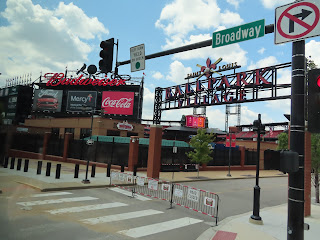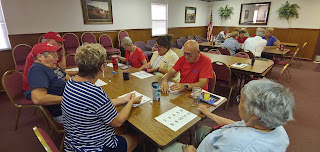We had a bus tour of St Louis, Missouri today. St Louis has lots of places to explore while touring US 66. But, no trip to St Louis is complete without a visit to the Gateway Arch, one of the city’s most famous landmarks. The world-famous St. Louis Arch has been known as "the Gateway to the West" since just about forever, which hails back to a time during which it really was the last, most westward town on the journey to the west coast of the US. It doubles as a National Park, so you can check that off your bucket list, too. Did you know it is the smallest National Park?
Founded by the National Park Service in 1935 to commemorate Thomas Jefferson’s vision of a transcontinental United States, the Gateway Arch National Park (formerly known as the “Jefferson National Expansion Memorial”) stretches from the Old Courthouse to the steps overlooking the Mississippi River. In between, the Gateway Arch rises high, a bold monument to the pioneering spirit. Today, the Gateway Arch celebrates the diverse people who shaped the region and the country. The dreamer, Thomas Jefferson, negotiated the Louisiana Purchase in 1803, doubling the size of the United States. The explorers, Lewis & Clark and their Shoshone guide Sacagawea, scouted the new territory and mapped a route to the Pacific Ocean. The challengers, Dred and Harriet Scott, filed suit at the Old Courthouse for their freedom from slavery, and St. Louis suffragette Virginia Minor sued for women’s right to vote. The artist, architect Eero Saarinen, designed the monument that honors them all.
The monument we know today began in 1935, when President Franklin D. Roosevelt designated property along the St. Louis riverfront to be developed as the Jefferson National Expansion Memorial (now known as Gateway Arch National Park). While the land was cleared for construction, the City of St. Louis deeded the Old Courthouse to the National Park Service to be incorporated into the Memorial. In 1948, a nationwide design competition determined what shape the Memorial would take, and in 1963, construction began on architect Eero Saarinen’s design for a stainless steel arch. Completed in 1965, the Gateway Arch stands as a symbol of national identity and an iconic example of mid-century modern design.
Anchoring the west end of the Park, the Old Courthouse is a prime example of mid-19th century federal architecture. Built in 1839, the Courthouse served as the site of a number of landmark civil rights cases, including the Dred Scott decision. In the 1830s, the enslaved Scott was taken to free territory in Illinois and Wisconsin before being brought back to Missouri. In 1847 and 1850, under Missouri’s “once free, always free” doctrine, Scott sued for his freedom at the St. Louis Courthouse. In 1857, the U.S. Supreme Court decided against Scott and his wife Harriet, ruling that African-Americans were not citizens and had no right to sue in court. Dissent over the decision helped to speed the start of the U.S. Civil War four years later.

While downtown, we enjoyed lunch at Salt & Smoke in, Ballpark Village. We dined on the 2nd floor outdoor bar and terrace area.
Baseball and barbecue fans alike have a new spot to kick back in Downtown St. Louis.
The food was amazing! The caravanners had a choice of Pulled Pork, Pulled Chicken, Salmon Sandwich or Brisket. Everything from the fries to the pies are made from scratch!
The restaurant, located in the base of the One Cardinal Way building in Ballpark Village, features a 5,500-square-foot first floor dining room, plus a 2,500-square-foot patio overlooking Busch Stadium.
The terrace gave us a perfect view of Busch Stadium and Ballpark Village. Located in the heart of St. Louis' central business district adjacent to Busch Stadium, Ballpark Village is the first-ever, sports-anchored, multi-phased/mixed-use development. Ballpark village hosts a variety of public and private events 365 days a year, providing patrons a variety of entertainment, food and beverage, and on-site parking in one location.
Cardinal’s baseball has been played in downtown St. Louis since 1966 and the club has played at three different ballparks known as Busch Stadium. The Cardinals first played at Sportsman's Park (renamed Busch Stadium in 1953) in North St. Louis, then moved to downtown St. Louis and into the circular, multipurpose Busch Stadium in 1966. The second Busch Stadium was not only home to the Cardinals, but too many other events including the St. Louis Cardinals NFL team before moving to Arizona. Busch Stadium was extensively remodeled in the 1990s, making it one of the best stadiums in baseball, even though it remained an enclosed stadium. However, in the late 1990s the Cardinals began to seek construction of a new stadium as ownership wanted to increase revenue from additional amenities such as luxury suites and club seats that old Busch Stadium lacked.
Fans and ownership agreed that the Cardinals home should remain in downtown St. Louis. However, the Cardinals struggled to receive support from the city and began exploring alternative options East of the Mississippi River in Illinois at a location near the Gateway International Raceway by 2000. The Cardinals located across the river in Illinois made little sense to anyone and by June 2001 fans rejoiced as the Cardinals and the State of Missouri signed a contract the construct a new ballpark in downtown St. Louis adjacent to Busch Stadium. Construction began in December 2003 and in August 2004 the Cardinals and Anheuser-Busch agreed on a 20-year naming rights contract to keep the Busch Stadium name alive. Busch Stadium is owned by the Cardinals and was privately financed using a combination of private bonds that the team is required to repay, bank loans, cash from the owners of the Cardinals and a long-term loan from St. Louis County.
The St. Louis Cardinals played their first game at Busch Stadium against the Milwaukee Brewers on April 10, 2006. As fans approach the ballpark they see a facade consisting of brick and steel, with arched openings at the main entrances, with the arches reminisce of nearby warehouses. Busch Stadium has a seating capacity of 46,700 that consists of three main seating decks with the main concourse, loge concourse, and terrace concourse levels. Bleachers are in both left and right field providing fans a different view of the action on the field. For the first three months of its opening Busch Stadium’s grandstand in left field was under construction as the new stadium overlapped the old Busch Stadium site and could not begin until the old stadium was completed demolished.
After lunch, we headed to Union Station. The first train pulled into Union Station on September 1, 1894 at 1:45pm, ushering in a new and exciting time for St. Louis. The city known for being the gateway to the West suddenly became a gateway to all of America. Over the next several years, Union Station would become one of the largest and busiest passenger rail terminals in the world. The station saw some of its highest traffic during the World’s Fair of 1904 and World War II. Travelers moved in droves through the station, where a regular day’s capacity of more than 100,000 people was normal, and the midway became the most popular spot to see and be seen. People like President Harry Truman, Joe DiMaggio, Joan Crawford and St. Louis baseball teams the Browns and the Cardinals all made appearances at Union Station. The final passenger train departed on October 31, 1978 at 11:38pm, closing the first chapter in the station’s history. While St. Louis Union Station lay dormant for a time, St. Louis itself continued to grow, bringing Busch Stadium, the Enterprise Center and City Museum right around the corner. Rather than let the grand architecture of Union Station go to waste, the building found new life. In August 1985, Union Station was reopened as a mixed-use complex featuring retail shops, event spaces and restaurants where tourists and locals alike could come and spend the day enjoying downtown St. Louis.
Today, Union Station is a balance of nostalgia and renovation. You can almost hear the trains coming into the platform, loved ones waving goodbye as soldiers head off to war and joyous hellos when they were welcomed home again.
But look up to see modern times—an innovative and breathtaking 3D light show set to music projects across the Grand Hall’s entire 65-foot vaulted ceiling. The renovations that have redefined the hotel and surrounding station will continue. Paying homage to the rich history of the city of St. Louis and Union Station, one of the major updates will be the restoration of the massive steel train shed, bringing it back to its original glory of more than 120 years ago. You can get a bird’s-eye view of the train shed and the iconic St. Louis skyline when they board the neighboring 200-foot St. Louis Wheel. Open year-round, the observation wheel features 42 enclosed gondolas, each equipped with seating for eight adults. And if folks are in the mood to splurge, one special “VIP” gondola has leather bucket seats, a stereo system and a glass floor. Frank & Fay took a ride on the St Louis Wheel!
Anchoring the entire Union Station development is the stunning St. Louis Aquarium. Located in the former retail space inside the station, the 120,000-square-foot attraction will feature one-of-a-kind exhibits and tanks housing thousands of aquatic species from the rivers and oceans of the world and will be an accredited member of the Association of Zoos and Aquariums.
All Aboard at the St. Louis Aquarium! The St. Louis Aquarium at Union Station will take you on an aquatic journey like no other. From snapping turtles to zebra sharks and community-building activities, the aquarium has something for everyone. Explore what awaits you!
Shark Canyon is the largest attraction found within the St. Louis Aquarium at Union Station. It offers views of 80 sharks and rays swimming in a 250,000-gallon environment with a J-wall that arches over the heads of visitors.
The St. Louis Aquarium features six different galleries.
Besides Shark Canyon, you can immerse yourself in the natural beauty and rich
history of the city’s two most prominent rivers, the Mississippi and Missouri,
in the Confluence Gallery as you can explore local aquatic species.
Next, Travel the river ways of South America, Africa and Southeast Asia in the Global Rivers Gallery. Come face to face with some of the world’s most unique animals and the important rivers in which they live.
After getting your fill of the “river monsters” visit with the otters and owls at the Changing Rivers Galleries.
The Ocean Shore Gallery is an interactive journey where kids
can meet some interesting and often misunderstood animals that live within the
shallows.
Finally, make your way to the depths of the ocean in The Deep Gallery to see the Coral, Jellyfish, sea dragons and so much more.
On the bus ride back to the campground, we enjoyed Ted
Drewes Custard. They have been selling frozen custard for over 80 years and has
become a popular treat for St. Louisans and tourists to enjoy! His attention to
quality has set the standard for frozen custard in St. Louis.
A road log briefing and games after … another great day with Yankee RV Tours!



































No comments:
Post a Comment